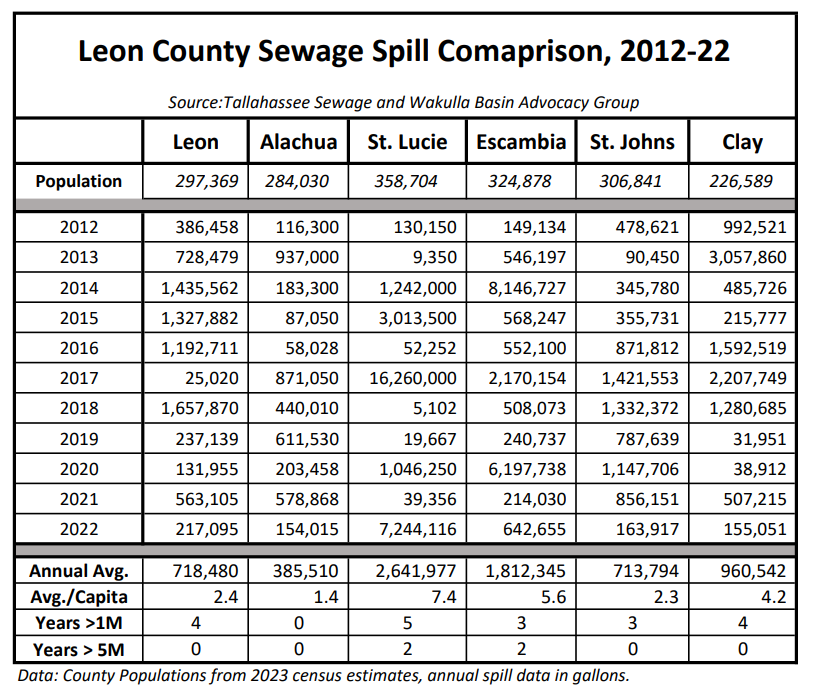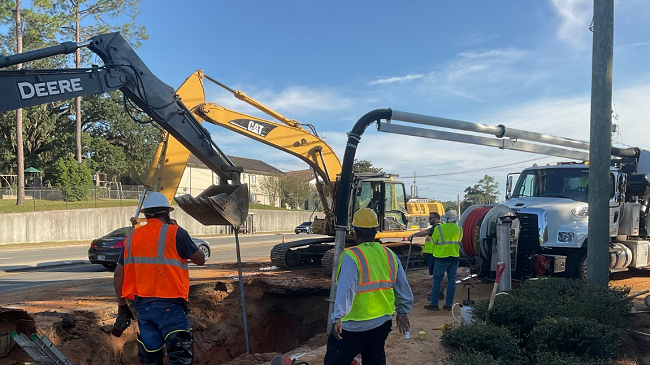A recent million gallon sewage spill on October 1st – in the area of Capital Circle NE and Mahan Drive – has raised concerns among some residents about the City of Tallahassee underground utility infrastructure.
Terry Ryan the co-founder of Tallahassee Sewage and Wakulla Basin Advocacy Group and Steve Schaefer, the manage of the City of Tallahassee’s underground utilities have recently appeared on The Steve Stewart Show to address concerns and answer questions. Those interviews can be found here.
Mr. Ryan voiced concerns about transparency and the lack of investment in an aging infrastructure.
Mr. Schaefer acknowledged previous problems, but discussed recent improvements over the last 10-12 years and said the system is meeting expectations.
As part of an ongoing analysis of the underground utility infrastructure, provided below is a chart that provides spill data comparisons. The source of the data is The Tallahassee Sewage and Wakulla Basin Advocacy Group’s Florida Sewage Spill website (www.multi-fin.com).
The comparison counties were selected based on populations relative to the Leon County population. Three of the counties have higher populations than Leon and two counties are less populous.
The comparison shows:
The average annual spill volume ranged from a low of 385,510 gallons (Alachua) to a high of 2,641,977 gallons (St. Lucie). Leon County had an annual average spill volume of 718,480.
The annual average per/capita spill during the period 2012-2022 ranges from a low of 1.4 gallons (Alachua) to a high of 7.4 gallons (St. Lucie). Leon County per/capita spill rate averaged 2.4 gallons.
For the comparison group, Alachua county had the lowest per capita spill rate and had no spills over 1 million gallons or 5 million gallons during the 2012-2022.
St. Lucie and Escambia counties had the highest per capita spill rate and the most years (2) with spills totaling over 5 million gallons.
Leon county had 4 years with over a 1 million gallons in spills and no years with over 5 million gallons.

A review of the above data indicates three Florida counties (St. Lucie, Clay, Escambia) with a similar population profile as Leon county had major spill issues during the period covered.
The data also reveals that Alachua county had the best results – in terms of spill volume – during the period reviewed.
Next, Tallahassee Reports will look at the number of spill events per year.


Another interesting comparison chart would be our graphs of sewage spills overlayed with yearly rainfall data. For Tallahassee, there’s a direct correlation between the two as is the State of Florida and several other counties. This is indicative of an aging and leaky (infiltration) system. The city is in the process if creating an abatement program to better define issues. The Advocacy Group has asked for a seat at the table on this project, yet, no response from the city.
Terry Ryan-CoFounder
Tallahassee Sewage and Wakulla Basin Advocacy Group
Mr Ryan,
Thank you for this valuable information and report. It is alarming that the city refuses to sample and analyze as this should be front page news. Please keep us informed.
DSP
That was very informative and some credible investigative reporting.
A competent city manager would never let the city fall into this state of disrepair regarding the infrastructure, crime, and fiscal irresponsibility. The Mayor, DW-C, and Curtis are holding the city back by not doing a nationwide search for a competent city manager.
Isn’t there some way to go to the state legislature and to declare COT/Leon County a state of emergency due to incompetence and corruption and remove the city manager / mayor?
Again, DPS good job.
Imagine how much higher our sewage spill rate would be if they included the content spewing from the local legacy rag!
The city is never going to have enough money, or personnel, to meaningfully affect the underground infrastructure moving forward. There will be sewer overflows. This is as good as it is going to get and it’s only going to get worse from here on out.
If you goto the talgov.com jobs site, the Underground Utilities Technician I, or II, or III listing shows 8 openings, water and sewer engineering has 2 vacancies (open since 6/23), Public Infrastructure Technician I, or II, or III has 10 openings (open since 6/23), Sewer Engineering & Inspection has been looking for a civil engineer since 3/23. Stormwater Management has two openings for program engineers open since 10/22.
The city just doesn’t pay enough to attract quality candidates, even for positions like those that maintain the sewer lines, and services will, in turn, suffer. Now that they are killing work from home, you can be the white collar jobs will never be filled. Sure, Goad and the rest are overpaid, but for field technicians at the City, the only ones left are the ones who have 15+ years in and have a pension in their sights. Nobody new is going to join and stay to learn the infrastructure, because they can get paid more literally anyplace else.
It’s well and good to say that it’s their job to protect the environment, which is technically a true statement, but without the ability to actually hire humans and put them into roles, it can’t be done.
“..Leon County had an annual average spill volume of 718,480…” since 2012. Honestly, that’s higher than I would have guessed. Since 2017, the Advocacy Group has been saying that although the NUMBER of annual spills have decreased since 2008 from a high of 300 spills, the VOLUME has become alarmingly high!
Also, Tallahassee has three Class III recreational lakes into which various major storm water ditches flow to (Lakes Jackson, Munson, and Lafayette) as does the effects of sewage spills. I’m not familiar with how the “comparison counties” dispose of their sewage spills. However, I don’t think the very environmentally conscience Tallahassee is ok with ANY amount of raw sewage flowing into our Class III recreational lakes! 500, 1,000, 5,000, 10,000, 100,000, 200,000, 500,000, 1 million gallons ok, Tallahasseans, city and county commissioners?
At the same time, other than witnessing regular Harmful Algal Blooms which cause human and pet major skin and respiratory medical issues, we don’t know how much sewage flows to the three lakes. Unfortunately, the city refuses to sample and analyze at the in-flow of each lake when a sewage spill occurs, the levels of not only eColi but, also, the myriad of nutrients and toxic contaminants in spite of repeated requests by the Advocacy Group to do so. Is the city afraid of what they will find? I am! The latest request being the 1 million sewage spill event which flowed into Weems Pond on the way to Lake Lafayette. City sampling analysis results at the time of the 1 million gallon sewage spill event showed an increasing trend at the Weems Pond Outfall, so, we’ll never know how much went into Lake Lafayette.
Terry Ryan – CoFounder
Tallahassee Sewage and Wakulla Basin Advocacy Group
“Like” us on Facebook
and sign our Lake Munson Restoration petition at https://www.change.org/RestoreLakeMunson
All this data shows is that cities/counties are not doing there jobs to protect our water resources by failing to making known problems with their aging waste water collection systems. Instead they defer to paying fines after sewage spills and the regulatory system allows them to supposedly make investments/improvements to their systems rather than pay fines. And the beat goes on as the incremental improvement approach to individual sewage spills fails to address other known system wide problems at the expense of our environmental resources.
All I’m saying is be prepared…get your Gumboots, gummies, rain boots, wellies,
and muck boots sooner than later. The city manager is focusing his attention on being the campaign manager for the mayor and you see the result… the high crime rate, sewage spills and fiscal irresponsibility. Tally Hose!
Ghazvini Canopy spill issues way beyond normal. And for this we get a tax increase?